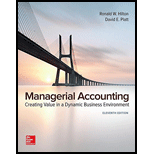
Managerial Accounting: Creating Value in a Dynamic Business Environment
11th Edition
ISBN: 9781259569562
Author: Ronald W Hilton Proffesor Prof, David Platt
Publisher: McGraw-Hill Education
expand_more
expand_more
format_list_bulleted
Question
Chapter 12, Problem 48P
1.
To determine
Write a memo to the president of Company N regarding its performance evaluation.
2.
To determine
Indicate a proper action for management.
Expert Solution & Answer
Want to see the full answer?
Check out a sample textbook solution
Students have asked these similar questions
What is the common side percentage forthe net fixed assets ?
Can you explain the correct methodology to solve this general accounting problem?
Hi expert please given correct answer with accounting question
Chapter 12 Solutions
Managerial Accounting: Creating Value in a Dynamic Business Environment
Ch. 12 - Why is goal congruence important to an...Ch. 12 - Define and give examples of the following terms:...Ch. 12 - Prob. 3RQCh. 12 - Explain the relationship between performance...Ch. 12 - What is the key feature of activity-based...Ch. 12 - What is the key feature of activity-based...Ch. 12 - Prob. 7RQCh. 12 - Define and give examples of the following terms:...Ch. 12 - Give an example of a common resource in an...Ch. 12 - Explain how and why cost allocation might be used...
Ch. 12 - Define the term cost allocation base. What would...Ch. 12 - Referring to Exhibit 125, why are marketing costs...Ch. 12 - Prob. 13RQCh. 12 - Why do some managers and accountants choose not to...Ch. 12 - Why is it important in responsibility accounting...Ch. 12 - Prob. 16RQCh. 12 - Prob. 17RQCh. 12 - What is meant by customer profitability analysis?...Ch. 12 - List seven areas in which nonfinancial,...Ch. 12 - Define the term manufacturing cycle efficiency.Ch. 12 - Prob. 21RQCh. 12 - What is meant by aggregate productivity, and what...Ch. 12 - Prob. 23RQCh. 12 - Using the Internet, identity the organizational...Ch. 12 - Prob. 25RQCh. 12 - Explain how an improvement in employee retention...Ch. 12 - For each of the following organizational subunits,...Ch. 12 - Prob. 28ECh. 12 - Prob. 29ECh. 12 - Xerox Corporation has been an innovator in its...Ch. 12 - The following data pertain to the Waikiki Sands...Ch. 12 - Lackawanna Community College has three divisions:...Ch. 12 - Countywide Cable Services, Inc. is organized with...Ch. 12 - Prob. 35ECh. 12 - Prob. 36ECh. 12 - Prob. 37ECh. 12 - Prob. 39PCh. 12 - Prob. 40PCh. 12 - Prob. 41PCh. 12 - Rocky Mountain General Hospital serves three...Ch. 12 - Refer to the organization chart for Rocky Mountain...Ch. 12 - Prob. 44PCh. 12 - Buckeye Department Stores, Inc. operates a chain...Ch. 12 - Building Services, Co. (BSC) was started a number...Ch. 12 - Warriner Equipment Company, which is located in...Ch. 12 - Prob. 48PCh. 12 - MedTech, Inc. manufactures diagnostic testing...Ch. 12 - Prob. 50PCh. 12 - Cathys Classic Clothes is a retailer that sells to...Ch. 12 - Pacific Rim Industries is a diversified company...
Knowledge Booster
Similar questions
- Solace Co. manufactures premium office chairs. During the most productive month of the year, 2,800 chairs were manufactured at a total cost of $98,000. In its slowest month, the company made 800 chairs at a cost of $50,000. Using the high-low method of cost estimation, what is the total fixed costs in October for Solace?arrow_forwardCan you demonstrate the accurate method for solving this General accounting question?arrow_forwardCan you show me the correct approach to solve this financial accounting problem using suitable standards?arrow_forward
- I need help solving this general accounting question with the proper methodology.arrow_forwardDelphi Corporation disposed of an asset at the end of the sixth year of its estimated life for $9,200 cash. The asset's life was originally estimated to be 8 years. The original cost was $42,600 with an estimated residual value of $3,400. The asset was being depreciated using the straight-line method. What was the gain or loss on the disposal? Answerarrow_forwardanswer ?? Financial accoutningarrow_forward
arrow_back_ios
SEE MORE QUESTIONS
arrow_forward_ios
Recommended textbooks for you
 Cornerstones of Cost Management (Cornerstones Ser...AccountingISBN:9781305970663Author:Don R. Hansen, Maryanne M. MowenPublisher:Cengage Learning
Cornerstones of Cost Management (Cornerstones Ser...AccountingISBN:9781305970663Author:Don R. Hansen, Maryanne M. MowenPublisher:Cengage Learning Managerial AccountingAccountingISBN:9781337912020Author:Carl Warren, Ph.d. Cma William B. TaylerPublisher:South-Western College Pub
Managerial AccountingAccountingISBN:9781337912020Author:Carl Warren, Ph.d. Cma William B. TaylerPublisher:South-Western College Pub Principles of Cost AccountingAccountingISBN:9781305087408Author:Edward J. Vanderbeck, Maria R. MitchellPublisher:Cengage Learning
Principles of Cost AccountingAccountingISBN:9781305087408Author:Edward J. Vanderbeck, Maria R. MitchellPublisher:Cengage Learning

Cornerstones of Cost Management (Cornerstones Ser...
Accounting
ISBN:9781305970663
Author:Don R. Hansen, Maryanne M. Mowen
Publisher:Cengage Learning

Managerial Accounting
Accounting
ISBN:9781337912020
Author:Carl Warren, Ph.d. Cma William B. Tayler
Publisher:South-Western College Pub

Principles of Cost Accounting
Accounting
ISBN:9781305087408
Author:Edward J. Vanderbeck, Maria R. Mitchell
Publisher:Cengage Learning